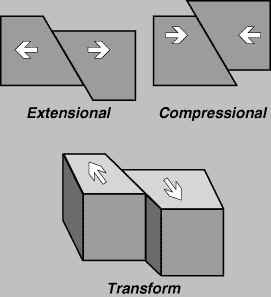![]()
All
earthquakes may be classified as one of three types,
tectonic, volcanic or artificial.
Tectonic earthquakes are caused by movements of the plates
which make up the crust of the earth. These earthquakes usually occur far below the
surface of the earth (as much as 400 miles) at the boundaries of the plates, where they
slide against one another causing a buildup of friction and pressure until a sudden
release of energy results in an earthquake. Infrequently, these types of earthquakes can
occur in the center of a plate when pressure builds and ruptures the plate. One such
earthquake, which occurred around 1811, was powerful enough to change the course of the
Mississippi River. Of the three types, tectonic earthquakes are the most devastating and
account for almost half of the world's destructive earthquakes and as much as
three-quarters of the earth's seismic energy.
Volcanic earthquakes are generally much smaller and less intense than tectonic ones. They
are caused when magma flows upward and fills the chambers beneath a volcano. The sides and
tops of the volcano swell and tilt with pressure and
result in numerous small earthquakes. Volcanic earthquakes are seldom destructive, but
have particular interest because they are often the forerunner for volcanic eruptions. The
eruption of Mount Saint Helens in Washington in 1980 is only one example.
Sometimes, earthquakes occur as a result of human actions such as when atomic explosives
are detonated underground or when new reservoirs are filled. These artificial earthquakes
are rare and relatively harmless when compared with the earthquakes caused by nature One
such series of earthquakes occurred in the early 1960s near Denver, Colorado, when waste
fluids were pumped into deep wells just east of the city. When the pumping stopped, so did
the earthquakes.
Earthquakes can also be classifed into three other sections namely extensional, compressional and transform, as shown below.

As you can see, extensional earthquakes move apart, compressional earthquakes press against each other and trasform earthquakes slide against each other.